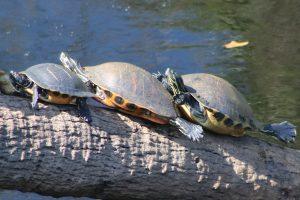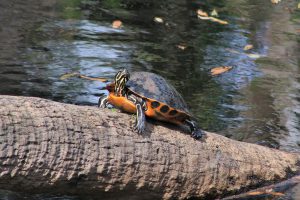From one hobby to another
While gardening is always a great thing to do, a person sometimes needs to take a break and go out and look at the world around us. This hobby has caused me to find the Florida Cooter.
What in the world is a cooter?
It is a native freshwater turtle, found throughout the state. In our area, we have two kinds of them to look for. We have both the Pseudemys floridana peninsular cooter, better known as a Peninsula Florida Cooter, and the Pseudemys nelsoni, or Red-Bellied Florida Cooter as well.
What do these turtles look like?
- Both are relatively large, from 9 to 13 inches long, not including head and tail.
- Maximum size is about 15 inches.
- The regular cooter has a yellow belly, a domed shell, and yellow to cream stripes on the head, tail, and legs.
- The Red Belly really does have an orange to reddish belly.
Where they live?
These turtles may be seen basking in the sun on logs, concrete ramps, and banks with their heads pointed to the sky. Besides coming out to bask, the only other reasons these turtles may leave the water would be to nest, or to find a new habitat during droughts or floods. Occasionally a nest may be found in a flower bed or yard. If so, it needs to be left alone for 90 days.
Their diet
- The cooters eat rooted aquatic plants, so are no threat to anglers.
- They do not dine on landscape plants either.
- Young ones may eat insects and some very small fish at first, but totally change to the aquatic vegetation diet when grown.
Life cycle
- The life cycle of a cooter is slow.
- This creature moves slowly, unless approached by a person.
- It takes a female 10 years to lay her first eggs.
- The females have an interesting habit of digging 2 fake nests, one on each side of the real nest, apparently to trick predators.
- The fake nests will have only one to two eggs in them, while the real nest may contain 5 to 30 eggs.
- If undisturbed, cooters may live up to 40 years.
While native wild animals take a minor toll on nests and hatchlings, more damage is done by such things as imported red fire ants, which attack the eggs and hatchlings. Habitat loss is also a major concern. Motorized boats and cars also take out a few. Humans used to take a toll by shooting and taking eggs, but all cooters are now protected by the FFWC. If you see one crossing the road, it is OK to help it across, in the direction it was headed. Compared to box turtles, the cooters are relatively heavy. Just don’t relocate them to another area, due to the possible spreading of disease.
Finding a Florida Cooter basking on a shoreline is always an interesting experience. Here are a few recent photos.

Florida Red Bellied Cooter

Both Red Bellied and Peninsular Cooters – photos Sandi Switek
ALL PHOTOS BY SANDI SWITEK
Need more information:
For more information about Florida Friendly Plants and Wildlife you can email me at epabon5@ufl.edu or like us to learn about new classes or events at Gardening in Central Florida
By: Sandy Switek since 2005 and Eva Maria Pabon Residential Horticulture Agent
Do you want to read more about gardening? Follow our blog Eva Pabon, Author at UF/IFAS Extension Osceola County (ufl.edu)
 3
3

